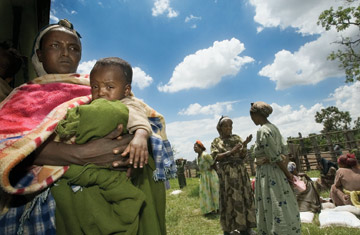
FACING THE FUTURE: Medina Genedo with her daughter Hamdiya Aman. Hamdiya is 2 years old, but poor nutrition has hindered her growth. Half of all Ethiopian children suffer from malnutrition
(2 of 2)
But since most food aid is donated by the U.S., the system won't change until Washington does. Congress is currently considering allowing up to 25% of the U.S. food-aid budget to be used on local products. But similar reform efforts have failed in the past. In April, the U.S. Government Accountability Office released a scathing report on how America underachieves in its attempts to feed the world, noting that the amount of U.S. food aid actually reaching beneficiaries has declined by 43% over the last five years because of escalating transport and administrative costs. "It's all well and good for the American public to feel good about their corn feeding starving people," says Edward Clay, senior research associate with the Overseas Development Institute, a London-based think tank. "But do American taxpayers realize that their money is being used to fund a hugely inefficient enterprise?"
On a broader level, emphasizing food-based charity diverts resources away from equally important issues. "With climate change, the periods between droughts in Africa are getting shorter and shorter," says Beatrice Karanja, who works with Oxfam in Nairobi. "As important as emergency food aid is, we need to focus more on solving the root causes of these problems."
Nevertheless, the first instinct of most governments is still to send bags of grain rather than pursuing longer-term solutions like building roads linking local farming communities with drought-suffering regions. Ethiopia, for example, is one of the largest corn growers in Africa, but poor transportation networks prevent most farmers from selling their crops outside their villages. And workers there fret that a predicted drought this year could trigger another famine. "My daughter has enough food for three months, and I am so grateful," says Genedo, as she lugs her 25-kg sack of grain back home. "But what do I do after that?"